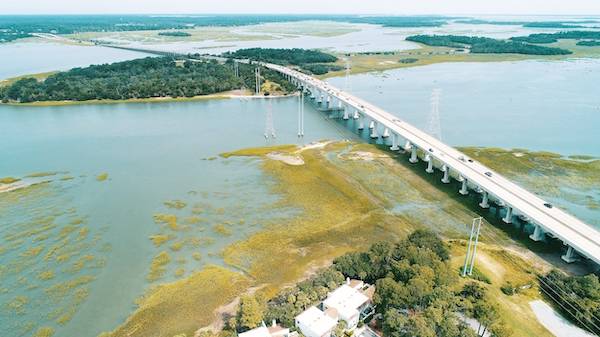Welcome to the November edition of our South Coast newsletter!
With wreaths lining the streets of downtown Beaufort, and many other communities in the South Coast, it’s safe to say the holiday season is officially upon us! While this year’s season is certain to be a strange one as we continue to navigate the uncertainties of an ongoing pandemic, I hope you are able to find safe and fulfilling ways to enjoy family time, wholesome meals, and our beautiful Lowcountry places.
We welcome your thoughts on how we can work together to enhance conservation on the South Coast. You can reach us at [email protected] and [email protected] or (843) 522-1800.
South Coast Wild Things

Each fall in the Lowcountry, native wildflowers treat us to a dazzling show. Reds, purples, yellows, and whites adorn Jasper County roadsides, shoulders of the Spanish Moss Trail, and any place we allow the wild to grow. Perhaps the most noticeable plant in the bouquet is goldenrod, the tall, brightly colored showstopper.
There are many native species of goldenrod in our state, including Tall Goldenrod (Solidago altissima), our official state wildflower. Despite its cheery disposition featuring bunches of sunshine-yellow flowers swaying even in the gentlest autumn breeze, goldenrod is often condemned by those who mistake it for ragweed, which aggravates our allergies. Though they share an autumn blooming period, goldenrod and ragweed don’t look anything alike. Ragweed is a nondescript plant with small green flowers and airborne pollen. Goldenrod, however, is a showy plant with yellow flowers that bear sticky, heavy pollen disbursed by pollinators. The wind doesn’t spread goldenrod pollen, which means it’ll never upset your nasal cavities.
Ironically, goldenrod can be used as a decongestant, treating the most common symptoms of seasonal allergies! The plant is actually a valued medicinal herb that was much beloved by Native American communities. It was used to treat anything from kidney disorders, to digestive issues, to superficial wounds. Goldenrod has been so highly valued as a healer that its genus name, “solidago,” means “to make whole.”
In the late 1920s, goldenrod almost became highly valued in a different way. At that time, Thomas Edison was searching for a renewable resource for rubber that could be grown in the United States and used to produce tires. Until then, we were solely reliant on rubber imports from other countries and leaders feared we’d be vulnerable if we were cut off from the supply chain. During Edison’s search, goldenrod was targeted and experimented with because of its high levels of natural latex. Unfortunately, Edison passed away before he could complete his research and develop a process, taking the notion of locally sourced renewable and biodegradable rubber with him. Not long after, our nation turned its attention to petroleum and coal-based rubber and plastic to fuel our love affair with the automobile.
The Conservation League in the South Coast

That love affair continues to this day as evidenced by the proliferation of sprawling, vehicle-centric communities and expansive networks of paved roads, bridges, and parking lots to support them. The Lowcountry is no stranger to the pressures of accommodating vehicular travel. Just this past year, the S.C. Transportation Infrastructure Bank awarded two major transportation projects based in Beaufort and Jasper counties—the U.S. Highway 278 bridge replacement/road expansion on Hilton Head Island and the new Exit 3 interchange on Interstate 95. We also know that the S.C. Department of Transportation is in the process of preparing for major widening and tree clearing along I-95. The initial widening project will cover 8 miles, starting at the Georgia border. In the years to come, I-95 will be widened all the way to U.S. Highway 17 at Point South. Each project is a response to the need to accommodate more cars while trying to address the congestion problems that come with them. And each will impose damaging impacts on our native wild habitats.
Fortunately, the Clean Water Act requires developers to avoid or minimize damage to wetlands, and to mitigate the damage when that isn’t possible. There are several ways to mitigate for unavoidable impacts, but the best methods include compensating for the damage in the same watershed and mitigating at the “landscape scale,” which considers the entire area or landscape where the project is being built, not simply the project area itself.
Unfortunately, mitigation is often implemented in a piecemeal fashion motivated by the lowest immediate cost. Typically, this means purchasing “credits” from a mitigation bank to restore, enhance, or preserve wetlands at a different location.
That’s why we have been working alongside local partner organizations to urge our state transportation agency to make the most of opportunities for mitigation that can help stitch wild habitats back together, restore wildlife corridors, protect more plant and animal species, store and filter more stormwater runoff, and absorb and store more greenhouse gases from the atmosphere. Simply put, in the same way goldenrod makes whole so does landscape-scale mitigation, by providing more meaningful long-term benefits and restoring our fragmented landscapes back into whole ecosystems.
Events, Activities, Meetings
Webinar: Exploring the Deep-Sea Corals – Friday, December 4, 9:30 to 10:30 a.m. Register here to join the Coastal Conservation League and Dr. Leslie Sautter, from the College of Charleston, for a webinar on one of the largest, continuous deep-sea coral reefs in the world, which sits just off our coast.
Wild Birds Unlimited Bird Walks – Saturday, December 12 & Tuesday, December 29, 7:45 a.m., Wild Birds Unlimited Store, 2139 Boundary Street, Beaufort. Come bird with me as I lead bird walks in birding hotspots around Beaufort. Birders will meet at the store and caravan to our destination. There is a $5 fee for the walk, and you must register in advance at the store. We can accommodate no more than 10 birders, so register soon. And don’t forget your mask and binoculars!
Volunteer Opportunity – The South Carolina Department of Natural Resources needs help collecting oyster shells from participating restaurants in Beaufort County so they can be recycled and used to rebuild oyster reefs along the coast. Email Ann Clark Little at [email protected] to learn more.
Due to Covid-19, many public meetings are being canceled or are streaming live to protect public health. Please check the status of each meeting prior to attending.
Beaufort County Council – December 14 at 6 p.m., Beaufort County Government Robert Smalls Complex, 100 Ribaut Road, Beaufort. Agendas, when posted, can be reviewed here.
Colleton County Council – December 8 at 6 p.m., Council Chambers in the Old Jail Building, 109 Benson Street, Walterboro. Agendas, when posted, can be reviewed here.
Hampton County Council – December 7 at 6 p.m., Council Chambers Administration Building, 200 Jackson Ave, East Hampton. Agendas, when posted, can be reviewed here.
Jasper County Council – December 7 at 6:30 p.m., Jasper County Clementa C. Pinkney Government Building, 358 Third Avenue, Ridgeland. Agendas, when posted, can be reviewed here.
